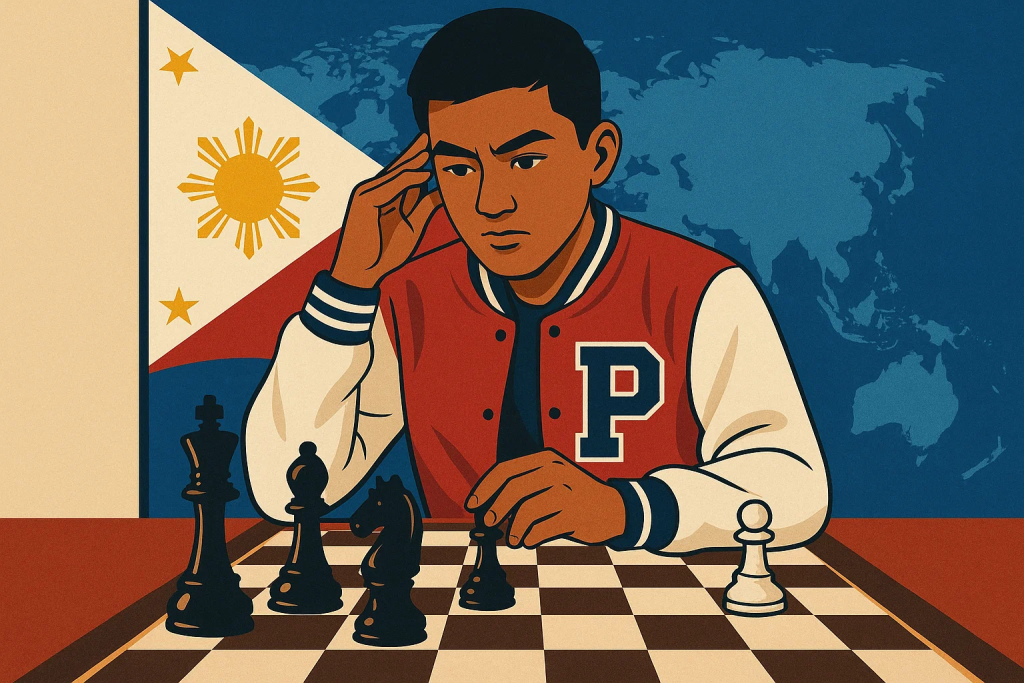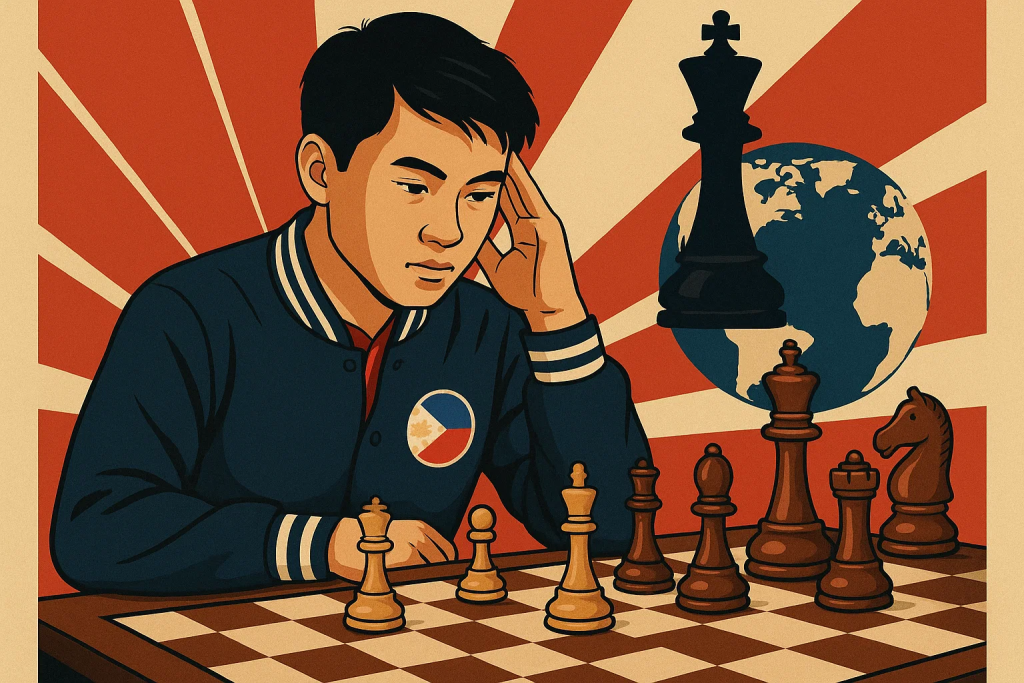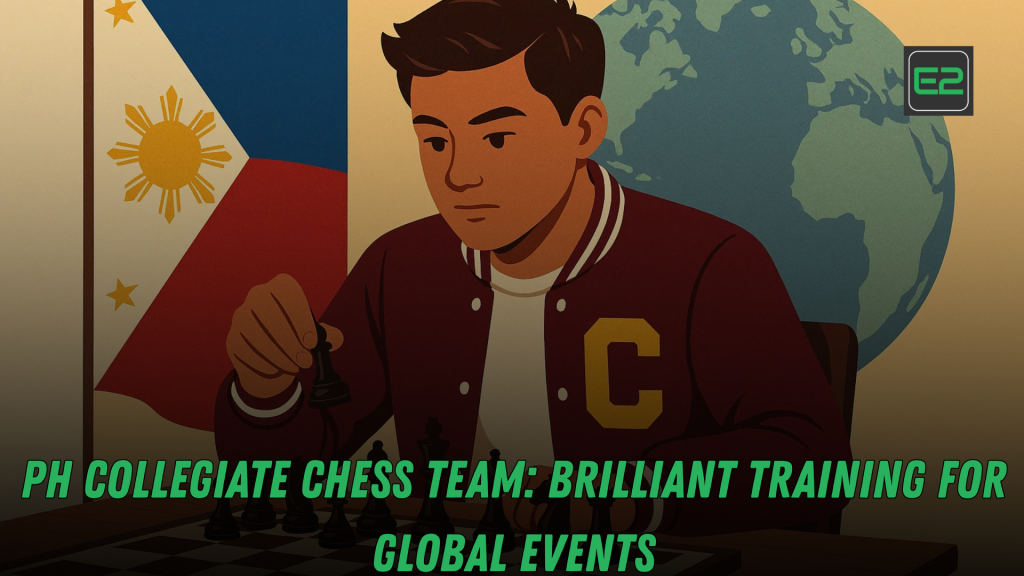Table of Contents
The PH Collegiate Chess Team stands at a pivotal moment. Filipino student-athletes are no longer satisfied with dominating campus circuits—they’re targeting Asian, world university, and open grand-festival events with a new playbook built on science, structure, and the unique grit of Filipino competitors. This long-form guide maps how the PH Collegiate Chess Team can raise its ceiling for global events: from periodized training and data-driven prep to sports psychology, travel logistics, and fundraising. If you’re a coach, player, alumni sponsor, or campus administrator, you’ll find practical steps to turn ambition into results—this season and the next.

Executive summary
- The PH Collegiate Chess Team needs a modern, year-round system: clear goals, role specialization, and cross-campus collaboration.
- Competitive edge comes from three pillars: structured study, game-ready mindset, and efficient recovery.
- Winning abroad requires logistics mastery—visas, budgets, nutrition, and acclimatization—managed with the same discipline as openings and endgames.
- Sustainable success is a community effort: alumni networks, corporate partners, and campus media must rally behind the PH Collegiate Chess Team.
Why global events matter now
International tournaments compress learning that might take a year at home into a single fortnight. Facing new openings, time-control styles, and psychological pressures stretches a player’s repertoire and resilience. For the PH Collegiate Chess Team, consistent exposure abroad builds:
- Rating acceleration: strong opposition produces truer rating signals and faster improvement.
- Depth under pressure: tie-breaks, must-win rounds, and double-round days harden decision-making.
- Recruiting magnetism: future scholars choose programs that travel, compete, and win.
- National prestige: a top result by the PH Collegiate Chess Team inspires juniors and attracts sponsors.
North Star goals for the next 24 months
- Team podium at at least one continental or world university meet.
- Two IM norms, one WGM/WIM norm produced by the PH Collegiate Chess Team program.
- Top-10 rapid & blitz finish in a global multi-event festival.
- Sustainable funding via a three-stream model: alumni, industry partners, campus grants.
Write the goals on the locker room wall. Every drill, scrimmage, and fundraising call should point the PH Collegiate Chess Team toward these benchmarks.
The training architecture: from chaos to cadence
1) Periodization: build, sharpen, peak
- Base (8–10 weeks): calculation habits, board vision, and endgame fundamentals.
- Build (6–8 weeks): repertoire updates, typical middlegames, and clock discipline.
- Peak (3–4 weeks): opponent-specific prep, rest optimization, and visualization.
The PH Collegiate Chess Team should never be guessing what to study on a given week; the calendar dictates the work.
2) Role specialization inside the squad
- Opening scouts: maintain theory files and trend notes.
- Endgame leads: run tablebase clinics and rook-endgame bootcamps.
- Psych captain: leads mindset routines, tilt-recovery protocols.
- Logistics officer: flights, visas, hotels, meals, and daily schedules.
Specialization keeps the PH Collegiate Chess Team efficient while developing leadership skills that transfer beyond chess.
Data-driven preparation: study smart, not just hard
Build a living database
- Curate PGNs of likely opponents (junior stars, regional rivals, exchange students).
- Tag by color, structure, time control, and result.
- Add comments: “prefers Maroczy plans”, “avoids endgames with opposite bishops”.
Three-layer prep model
- Macro layer: typical pawn structures the PH Collegiate Chess Team expects to face (Caro-Kann, Najdorf, Catalan, London).
- Meso layer: key middlegame motifs (minority attack, kingside pawn storm, blockade patterns).
- Micro layer: opponent-specific novelties, move-order tricks, and time-trap tendencies.
Clock analytics
Track average move time on critical moves, time collapse after move 30, and accuracy drops in increment time controls. Many matches swing because players mismanage minutes, not moves. The PH Collegiate Chess Team must practice with the same increments and breaks the target event uses.
Opening design: weaponize simplicity
An opening is “good” if it generates positions you understand better than your opponent. For the PH Collegiate Chess Team, the best repertoires share traits:
- Resilient vs. prep: choose lines with several healthy move-orders.
- Structure-first: emphasize pawn-structure families so knowledge transfers across openings.
- Prepared surprises: keep one “spike” per player—a sideline they love and opponents rarely check.
Examples of practical choices
- As White: 1.d4 with London/Catalan hybrids; or 1.e4 with Anti-Sicilians to dodge opponent files.
- As Black: Flexible …e6 or …g6 systems aiming at familiar structures, not memorization fights.
The PH Collegiate Chess Team should codify “go-to” plans (piece placement, pawn breaks, typical sacrifices) in one-page cheat sheets for quick review on travel days.
Calculation, intuition, and pattern memory
Calculation drills (20–30 minutes/day)
- Depth ladders: start with 3-move lines, climb to 6–7 ply with blunder checks.
- Hidden resources: set positions where only in-between moves or quiet retreats save the day.
- Visualization walks: solve with eyes closed for 1–2 minutes to train board memory.
Pattern library
Maintain a private library of tactical motifs—deflections, back-rank tricks, Greek gifts—tagged by opening family. When the PH Collegiate Chess Team reviews games, label each tactic with the originating structure. Patterns stick when context is attached.
Endgames win tournaments
Invest 25–30% of study time here. Non-negotiables for the PH Collegiate Chess Team:
- Rook endgames: Lucena, Philidor, checking distance, and “cut the king”.
- Minor-piece endings: good vs. bad bishop, knight outposts, “wrong bishop” rules.
- Opposite-colored bishops: fortress building and break timing.
- Practical technique: converting extra pawn with rooks on, triangulation under increment pressure.
Run ladder simulations: worse position → equal → slightly better → winning. The PH Collegiate Chess Team should practice converting won positions in 90 seconds or less on the clock—because that will happen on boards 3–5 late in matches.

Sports psychology: the fourth dimension
Chess is a decision sport. Manage emotions, manage results.
Pre-game routine (7 minutes)
- Breath box (4-4-4-4).
- Self-cue: a short phrase (“calm & calculate”).
- Trigger review: one page of structure plans.
- Visualization: first 10 moves in your favored lines.
In-game resets
- After a blunder: write a dot on the scoresheet margin, sip water, and play the simplest safe move next.
- Against time trouble: switch to “threats first” evaluation—create two problems per move.
Post-game debrief
No engine for 15 minutes. First, annotate feelings and plans. Then check with silicon. The PH Collegiate Chess Team should normalize sharing mistakes; vulnerability speeds growth.
Physical conditioning for cognitive stamina
Long rounds demand body care. A basic protocol for the PH Collegiate Chess Team:
- Mobility: 10-minute morning routine (neck, shoulders, hips).
- Cardio: 2–3 sessions/week (20–30 minutes) to aid stress recovery.
- Strength: 2 sessions/week (light compound moves) for posture and endurance.
- Sleep bank: grow “sleep capital” before travel weeks.
Nutrition that travels
- Pre-round: low-GI carbs + protein (banana + yogurt; oatmeal + nuts).
- During play: water sips each move 20, small bites at time control.
- Post-round: protein + carb within 45 minutes; short walk; light stretch.
Avoid heavy, oily meals close to start times. The PH Collegiate Chess Team should map nearby groceries at each event city to control costs and choices.
Scrimmage culture: iron sharpens iron
- Theme matches: Najdorf day, French day, Catalan day.
- Score pressure: first to 3 wins from equal positions, then switch to worse positions.
- Simul with time odds: top board gives 5+2 vs. others’ 10+2.
- Clutch sets: start from move 30 with 5 minutes each, equal endgames.
Scrimmages must look like tournaments. Schedule them at the same local time as expected rounds to engrain circadian rhythm for the PH Collegiate Chess Team.
Travel playbook for overseas events
8–10 weeks out
- Confirm visas, passports, invitation letters.
- Block flights with good arrival times for acclimatization.
- Reserve walkable hotels or reliable shuttles.
2–4 weeks out
- Finalize rooming lists, meal plans, and local SIM cards.
- Build daily schedules (wake, prep, round, recovery, team huddle).
On site
- Arrival day: short walk, light tactics, early sleep.
- Rest days: blitz for joy, not study marathons.
- Departure: thank organizers; collect receipts.
The PH Collegiate Chess Team should measure travel fatigue: resting heart rate, sleep hours, subjective energy. Adjust next-day expectations accordingly.
Budgeting and fundraising
A clear budget invites support. Typical line items for the PH Collegiate Chess Team:
- Airfare, lodging, meals, entry fees, insurance, visas, uniforms, team gear.
- Contingency (10–15%) for schedule changes and medical needs.
Three-stream funding
- Alumni pledges: monthly micro-donations add up; offer naming rights for boards or sets.
- Corporate partners: highlight STEM and problem-solving synergy; propose internship pipelines.
- Campus grants: position the program as an academic-adjacent excellence track.
Create a prospectus with photos, impact numbers, and a seasonal calendar. The PH Collegiate Chess Team must pitch like a startup—because it is one.
Content and media that build a movement
- Matchday cards: pairings and results in campus colors.
- Learning reels: 60-second motif explainers by team members.
- Behind-the-boards: travel diaries humanize the grind.
- Faculty shout-outs: thank professors who accommodate schedules.
The more stories told, the more the PH Collegiate Chess Team becomes a campus identity, not just a club.
Governance and culture
Winning programs run on trust and clarity.
- Code of conduct: punctuality, respectful analysis, social media etiquette.
- Selection policy: transparent criteria (ratings, form, attendance, scrims).
- Academic guardrails: study halls on the road; grade-check system; faculty liaison.
- Feedback loops: monthly one-on-ones; anonymous suggestion forms.
Culture compounds. The PH Collegiate Chess Team should celebrate process milestones as loudly as trophies.
Risk management
- Health & safety: travel insurance, first-aid kit, emergency contacts.
- Cyber hygiene: device locks, offline prep backups, two-factor authentication.
- Financial controls: two-signature policy for expenses; simple, auditable books.
Prepared teams stay calm. Calm teams see more tactics.
Sample 12-week ramp to a global event
Weeks 1–4 (Base)
- Daily tactics (20–30 min), endgame fundamentals, long-form classical sparring (once/week).
- Cardio 2x, strength 2x.
- Build opening menus; annotate three model games per structure.
Weeks 5–8 (Build)
- Opponent archetypes identified; rehearsal vs. structure families.
- Two classical sparrings/week + one rapid day.
- Mindset: visualization starter pack; routine locked.
Weeks 9–10 (Peak)
- Targeted novelties, time-pressure drills, clutch endgames.
- Reduce volume, keep intensity.
- Logistics frozen; sleep bank starts.
Weeks 11–12 (Taper & Travel)
- Light tactics, rest, strategy flashcards.
- Arrival acclimatization; short walks, hydration, early nights.
This rhythm gives the PH Collegiate Chess Team freshness without rust.
Checklists
Travel kit
- Passports/visas, invitation letters, insurance cards, team polos, power adapters, snacks, refillable bottles, small notebook, pens, compression socks, OTC meds.
Round-day
- Wake stretch → breakfast → 20-minute tactics → 10-minute walk → board check → breath routine → PH Collegiate Chess Team huddle → game.
Post-round
- Handshake → brief emotions note → meal → 30-minute cool analysis → light walk → shutdown screens.
Alumni & mentor network
Invite titled alumni and industry pros to:
- Host monthly masterclasses.
- Review top team games.
- Offer mock interviews and internships.
- Sponsor boards, clocks, or travel slots.
The alumni-mentor loop keeps the PH Collegiate Chess Team future-proof.
Blueprint for a high-impact campus chess center
- Quiet analysis room with demo board and projector.
- Open library: classics + modern repertoires.
- Recording corner for lesson videos.
- Community hours where juniors and beginners meet varsity members.
This becomes the beating heart of the PH Collegiate Chess Team: a place where passion becomes skill.
Case study (composite scenario)
A Manila-based PH Collegiate Chess Team targeted a continental university championship in 20 weeks. They adopted periodization, doubled endgame time, and introduced travel-time sleep banking. Sponsorship covered 60% of costs after a well-produced pitch deck. Arriving three days early, they adjusted to climate and food. Results: team silver, one IM norm, two board medals, and a surge of applicants to their next tryouts. The win began months earlier—with organization, not just openings.
Common pitfalls (and fixes)
- Over-prepping openings, under-prepping endgames → flip the ratio.
- Ignoring sleep and meals → performance nosedives; schedule both like rounds.
- Silent tilt after a loss → normalize debriefs; name feelings; reset.
- Last-minute logistics → build templates the PH Collegiate Chess Team can reuse.
- One-coach bottleneck → distribute roles; grow captains.
Call to action
If you’re reading this, you already care. Now act:
- Players: commit to a 30-day calculation + endgame streak.
- Coaches: draft a 12-week plan and assign team roles by Friday.
- Alumni: pledge a monthly gift and volunteer one masterclass this semester.
- Administrators: unlock a campus space and travel support for one global event.
The window is open. Help the PH Collegiate Chess Team step through it—together.
Final word
Excellence is a system, not a slogan. With periodized training, smart logistics, fearless competition, and a vibrant community, the PH Collegiate Chess Team can turn global dreams into consistent podiums. Start now—every focused session today is a point on the scoreboard tomorrow.
PH Amazing Frisbee League Launch in QC: Everything You Need to Know
The piece lays out a blueprint for the PH Collegiate Chess Team to contend at global events: set 24-month goals (podium finish, IM/WIM norms, top-10 rapid/blitz, sustainable funding), build a periodized training system (base, build, peak), specialize roles (opening scouts, endgame leads, psych captain, logistics officer), and rely on data-driven prep, resilient openings, daily calculation/endgame work, and sports psychology routines. It adds physical conditioning, travel and nutrition playbooks, scrimmage culture, budgeting/fundraising, media strategy, governance, risk management, and a 12-week ramp to peak. Alumni networks, campus support, and metrics-driven reviews power sustainable growth and consistent podium results.

Frequently Asked Questions (FAQs)
1) How often should the PH Collegiate Chess Team scrimmage at classical time controls?
Once weekly is ideal during base/build phases; taper to one lighter classical plus rapid sets near events. Consistency beats marathons. The PH Collegiate Chess Team should match scrimmage times to expected round starts.
2) What is the fastest rating gain lever for the PH Collegiate Chess Team?
Endgame technique under time pressure. Convert won positions, save drawn ones, and avoid tilt after inaccuracies. This steadies team boards 3–5 where matches are decided.
3) How can the PH Collegiate Chess Team prevent burnout during heavy travel?
Bank sleep pre-trip, schedule short walks, eat predictable foods, and keep rest days playful (blitz for joy). Use debriefs to offload stress and agree on media blackout windows.
4) What fundraising pitch works best for the PH Collegiate Chess Team?
Tie chess to academic excellence and problem-solving. Offer clear benefits: naming rights, internship pipelines, campus recognition. Present a seasonal plan, not a one-off request.
5) Which metrics prove progress for the PH Collegiate Chess Team?
Team match points, board performance vs. stronger opposition, endgame conversion rates, time-management accuracy, and academic compliance. Share these in quarterly updates to stakeholders.
